In this edition of the roundup of important court judgments, we look at cases where the courts issue important directions about the importance of Anganwadi centres, discharge of untreated effluents into rivers, right to privacy of inter-faith couples, and advertisements propagating sale of items claiming supernatural/miraculous powers.
SC directs reopening of Anganwadi centres outside containment zones
In a Public Interest Litigation (PIL) titled Dipika Jagatram Sahani vs. Union of India and others, the Supreme Court directed the reopening of Anganwadi Centres (outside the containment zones), which were closed due to pandemic.
The court held that the provision of food grains, as per the provisions of the National Food Security Act, 2013 is a statutory obligation on the State. In accordance with the statutory requirements of the Act, Anganwadi centres provide nutritional support to children, pregnant women and lactating mothers. The pandemic has caused severe strain on the employment and means of livelihood of a large sections of the society especially marginal sections. Inadequate supply of nutritious food to the citizens, more particularly to the children and the women shall affect their health. Therefore, the court held that the same shall be in violation of their fundamental right to health/right to live with dignity guaranteed under Article 21 of the Constitution of India.
The judgement highlights that the Government of India by its guidance note permitted all the States and Union Territories to open Anganwadi Centres. Hence, it is the obligation of the States/Union Territories to take decision for opening of these centres. Several States/Union Territories have already started running the centres.
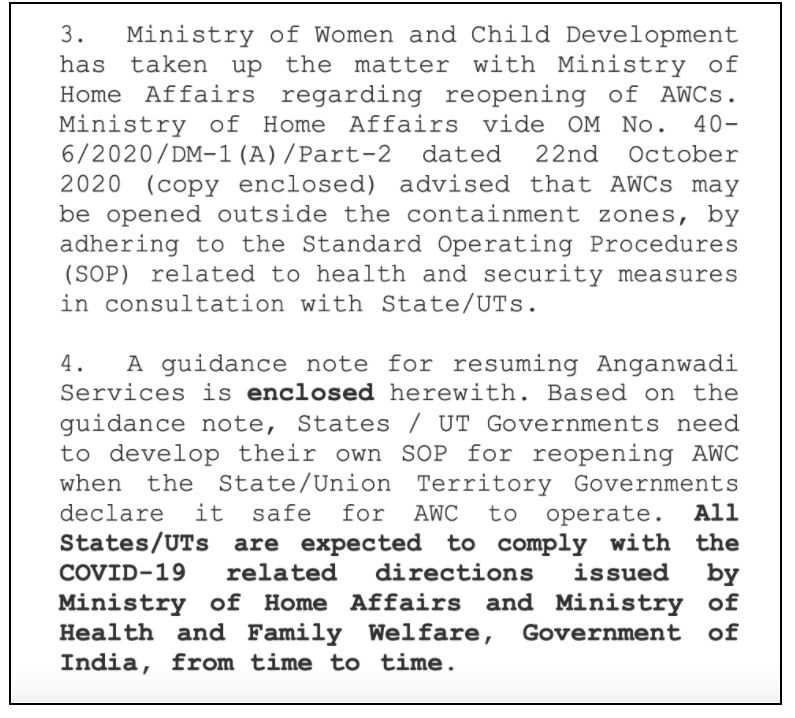
The judgment also mentions that in the month of September 2020, the National Human Rights Commission issued an advisory on Right to food security and nutrition in context of COVID-19, stating that all ICDS centres should be recognised as essential services and reopened with adequate safety protocols.
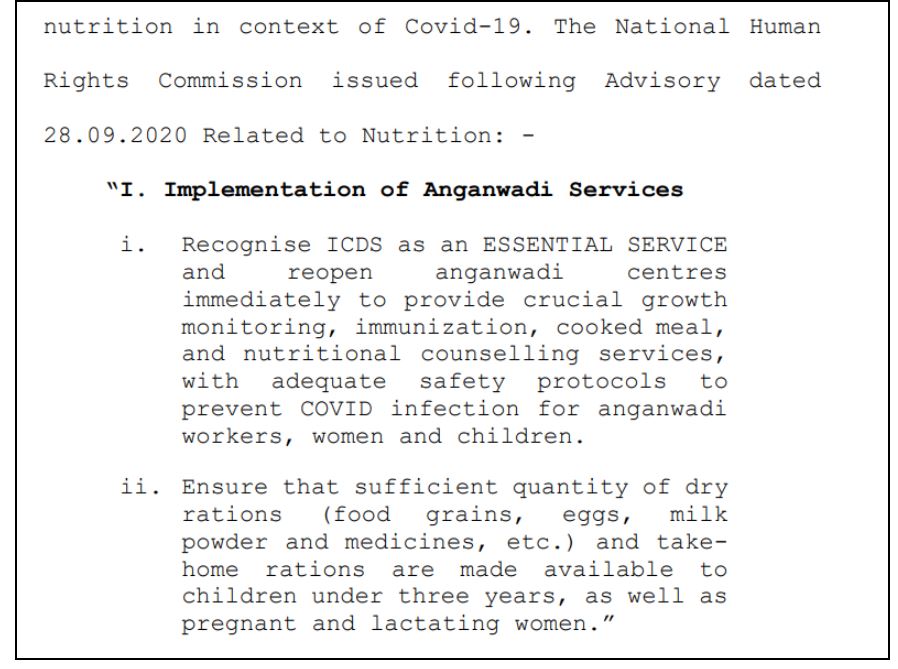
In conclusion, the bench of Justice Ashok Bhushan, Justice Subhash Reddy and Justice M.R. Shah was of the view that unless there are any specific reasons for not opening of Anganwadi Centres, all Anganwadi Centres beyond the containment zones should be made functional by all the States/Union Territories at an early date. The judgement also clarified that centres situated in the containment zone shall not be opened till the containment continues.
The court also asserted that the decision for not opening Anganwadi centres in any State/Union Territories or any part of State/Union Territory shall be taken only under the direction of the State Disaster Management Authority.
It further directed all States/Union Territories to issue necessary orders regarding monitoring and supervision of Anganwadi Centres to ensure that the benefit reaches the beneficiaries and a Complaint Redressal Mechanism be put in place in each district.
SC takes Suo Moto Cognizance on the issue of “remediation of polluted rivers”
While hearing a petition filed by Delhi Jal Board seeking urgent directions on the Haryana Government to stop the discharge of untreated effluents resulting in a rise of ammonia levels in Yamuna river, the court took suo moto action on the issue of contamination of rivers by sewage effluents and directed that the mandate is implemented by municipalities as far as the discharge of sewage into rivers is concerned.
The bench of Chief Justice of India S.A. Bobde, Justice A.S. Bopanna, and Justice V. Ramasubramanian observed that non treated/ partially treated municipal waste and effluents are one of the major causes of water pollution.
The judgement expressed that deterioration of the quality of freshwater has a direct correlation with the quality of public health. The court observed that it has become necessary, to compare the costs of prevention and control of water pollution against its effects on human health including treatment, indirect economic costs, and damage to flora and fauna.

The bench also referred to the judgement in Narmada Bachao Andolan v. Union of India, (2000) and held that the right to a clean environment and further, pollution-free water has been protected under the broad rubric of the right to life guaranteed under Article 21.
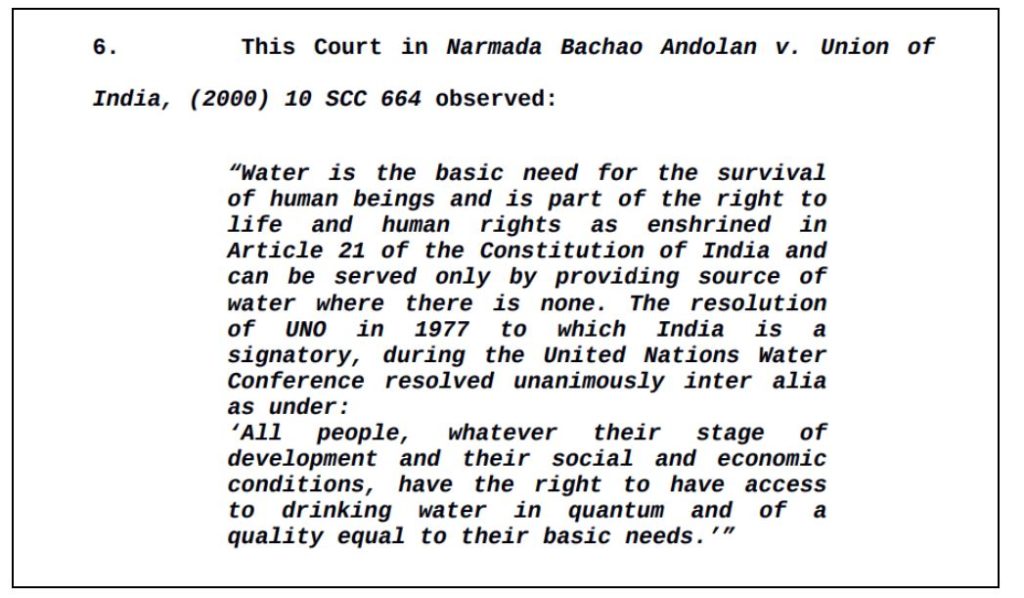
It highlighted that over the years, there have been many legislative and executive actions to ensure this basic right of pollution-free water. The Water (Prevention and Control of Pollution) Act, 1974 was enacted with an objective to provide for the prevention and control of water pollution and maintaining or restoring of wholesomeness of water. The Act prohibits the use of any stream or well for disposal of polluted matter.
The court notes that although the mandate of law is clear as far as setting up of Sewage Treatment Plants (STPs) and stoppage of sewage effluents in surface water are concerned, it is often found as highlighted by the Delhi Jal Board petition that either the sewage is not treated through a plant before being discharged or the treatment plants are not functional or incapacitated.
In conclusion, the court directed for taking up a suo moto action on the issue of remediation of polluted rivers. The court issued notices to the State of Uttarakhand, Himachal Pradesh, Haryana, Delhi, and Uttar Pradesh along with the Ministry of Environment, Forest and Climate Change, Ministry of Housing and Urban Affairs, and Central Board of Pollution Control.
The SC also directed the Central Pollution Control Board (CPCB) to submit a report identifying municipalities along the river Yamuna, which have not installed total treatment plants for sewage as per the requirement or have gaps in ensuring that the sewage is not discharged untreated into the river and to also submit a priority-wise list of Municipalities, the river stretches adjacent to which have been found to be most polluted.
Allahabad HC: Mandatory publication of notice under the Special Marriage Act 1954 (SMA) violate Right to Liberty and Privacy
In the case of Safiya Sultana vs. State of Uttar Pradesh, the high court held that the requirement of publication of notice of intended marriage under Section 6 and inviting/entertaining objections under Section 7 of the Special Marriage Act, 1954 is not mandatory.
The court was hearing the plea filed by an inter-faith couple who expressed that they could have solemnized their marriage under the Special Marriage Act, 1954 but the said Act requires a 30 days’ notice to be published and objections to be invited from the public at large. They expressed that any such notice would be an invasion of their privacy and would have definitely caused unnecessary social pressure/interference in their free choice with regard to their marriage. They further stated that such a challenge is being faced by a large number of similarly situated persons who desire to build a life with a partner of their own choice.

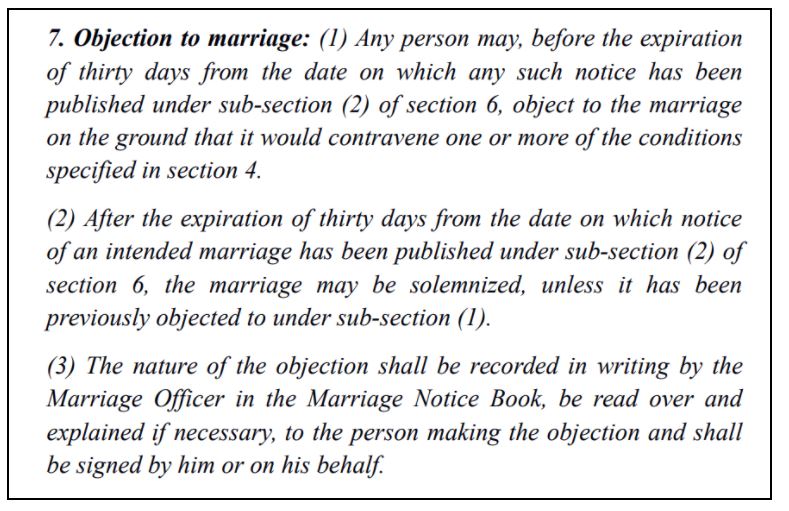
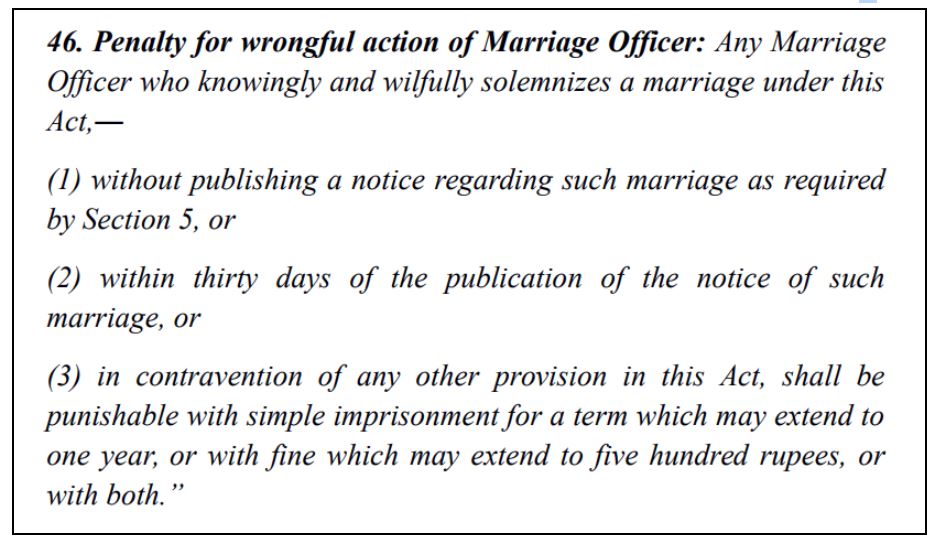
In view of Sections 6 & 7 and more specifically in view of the punitive consequences under Section 46, the publication of notice under Section 6 and inviting objections and decision thereupon under Section 7 is treated as mandatory under this act. Thus, the Officers have always published a notice of intended marriage and invited objections. Marriages under the Act of 1954 are only solemnized after a period of thirty days of notice or after the decision on the objections, in the case filed.
The judgement cites the 59th, 212nd, 242nd Report of the Law Commission of India, which proposed amendments in the Act of 1954 as well as in the Hindu Marriage Act, 1955. Among a host of recommendations, one was to simplify the procedure under the Act and remove the requirement for publication of notice of intended marriage. However, the Bills proposed by the Law Commission in its reports No. 212 (2008) and 242 (2012) are still pending consideration.

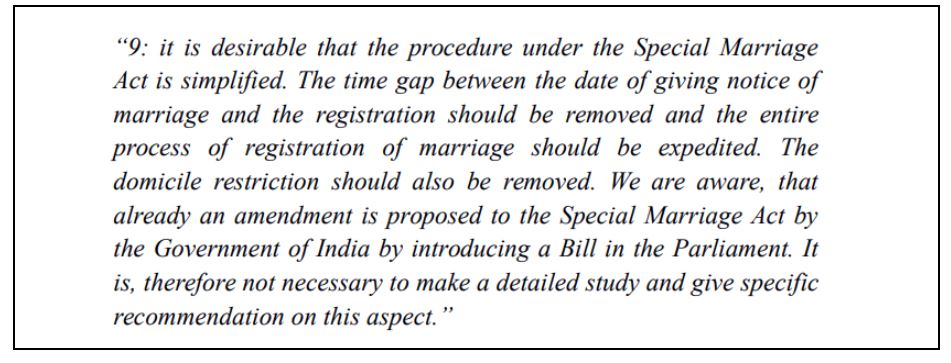
The judgment also takes note of previous cases of inter-faith or inter-caste marriages where people approached the court upon suffering from unnecessary objection to their intended marriage or violence at the hands of family members, relatives, or other non-state actors. It also takes note of the fact that marriages in India can be performed either under personal laws or under the Act of 1954. The marriages under personal laws do not require publication of any notice or calling for objections regarding such a marriage.
In conclusion, the high court held that on their simplistic reading, sections 6 and 7 of the Special Marriages Act 1954 are mandatory and hence they violate the fundamental rights of liberty and privacy, including within its sphere freedom to choose for marriage without interference from state and non-state actors, of the persons concerned. The judgement directed that such publication of notice and the further procedure can only be read as a directory in nature, to be given effect only on request of parties to the intended marriage and not otherwise. In case they do not make such a request for publication of notice in writing while giving notice under Section 5 of the Act, the Marriage Officer shall not publish any such notice or entertain objections to the intended marriage and proceed with the solemnization of the marriage.
Bombay HC: Bans propagation for sales if item claiming miraculous or supernatural powers via a television advertisement
In the case Rajendra v. UOI and others, the high court was hearing a petition filed to prevent the advertisement made on TV channels by which there is the promotion of the sale of articles like Hanuman Chalisa Yantra claiming that it possesses special, miraculous, and supernatural properties/ qualities. In the advertisement, there was a claim that by using aforesaid Yantra, the businessmen who were making losses had started making huge profits, the persons who were not having employment had got employment, the persons who had lost hope to make career had made career in service, the students had improved their performance, sick persons had recovered from illness and the persons who were not having any prospects of marriage had got married. Celebrities like Manoj Kumar (the then renowned film producer, writer, director, actor), Anuradha Paudwal (singer), and Anup Jalota (singer) were shown in the advertisement and their experiences were quoted. The plea stated this was false propaganda made to exploit persons who are superstitious by nature.
A bench of Justice Tanaji Nalawade and Justice Mukund Sewlikar held that the propagation for sale by the advertisement of any article with representation that these articles have special, miraculous, and supernatural properties/qualities are illegal and such propagation, advertisement falls under Section 3 of the Maharashtra Prevention and Eradication of Human Sacrifice and other Inhuman, Evil and Aghori Practices and Black Magic Act, 2013.

The judgement also highlights the “Programme Code” of the Television Networks Act 1995 which lays down ethics for advertisements on TV channels.

Therefore, the court held that the TV channel, which is telecasting such advertisement, is also liable under the provisions of the Maharashtra act banning black magic.
The bench directed the state government to see that the telecast of such advertisement on TV channels is immediately stopped in coordination with the authority created by the Central Government under the Cable Television Networks (Regulation) Act, 1995. It also directed the State to register crimes by giving reports against the persons, who are making such advertisement and who are selling such articles.
Featured Image: Review of court decisions


